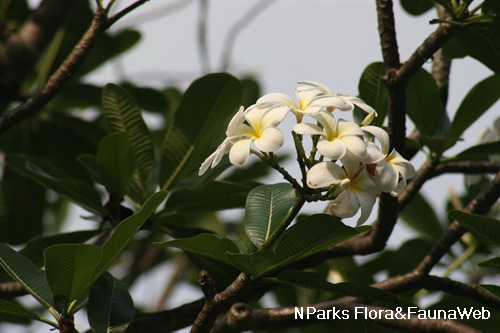
Back
Plumeria obtusa
| Family Name: | Apocynaceae |
| Common Name: | Great White Frangipani, Frangipani, Temple tree, Singapore graveyard flower, Cempaka, Chempaka, Kemboja, Bunga Kubur, Great Frangipani, Singapore Plumeria |
Name
Classifications and Characteristics
| Plant Division | Angiosperms (Flowering Seed Plants) (Dicotyledon) |
|---|---|
| Plant Growth Form | Tree (Small (6m-15m)) |
| Maximum Height | 5 m to 12 m |
| Maximum Plant Spread / Crown Width | 9 m |
Biogeography
| Native Distribution | Tropical America |
|---|
Description and Ethnobotany
| Others - Plant Morphology | Growth Form: Large shrub or small tree with an irregular or rounded crown that grows up to 12 m. Evergreen in the tropics, but deciduous in temperate climates. Habitat: Occurs along the coast on rocky or sandy, nutrient poor soils. Trunk: Trunk short with branching at about 1.5 - 2 m. Bark is grey and smooth. Branches: Highly branched with thick, but fragile branches. Branches knobby due to small, outgrowths of cork. Foliage: Leaves glossy and obovate with blunt ends (15 - 25 cm long). They are arranged in a spiral cluster with most leaves concentrated at branch tips. Flowers: Flowers have large, waxy petals that form a funnel shape (9 - 10 cm wide). Each inflorescence stalk consists of several flowers (18 - 30 cm long). Flowers occur mainly at the branch tips, but also along the sides of branches. This species flowers throughout the year in tropical environments. Their fragrance is strong and especially intense at night to attract pollinating moths. In the morning, many flowers drop off. Flower buds are covered by a thin coat of resin. Fruits: Fruit are cylindrical recurved pods (15 - 17.5 cm long, 1.8 cm wide) that contain numerous flat seeds with a single, short wing on one side. Fruits are initially green, and then become black at maturity. They split on one side of the pod, releasing the seeds. Landscaping: Often used as an ornamental shrub or tree in gardens and parks. The tree does not provide much shade, but it is an attractive roadside tree. Some Malay Muslims feel that the tree's habit of dropping flowers in the morning represents an offering of flowers to the dead. Thus, Indian and Malay Muslims, as well as Buddhists, often plant this particular species in graveyards. In Singapore, some people are reluctant to use this species for normal ornamental purposes, because they associate the white flowers with funerals and graveyards. Hindus sometimes plant this species near their temples. Cultivation: Fertilize plants every 2 weeks during the growing season. Use a fertilizer with a high phosphate content, such as one with an NPK of 10-50-10. Plant in slightly acidic or neutral soil (pH 6.6 - 7.5) with high organic matter content (eg., compost, manure, leaf mold) and good drainage. A soil with coarse texture, such as sandy soil or sandy loam, is ideal. The plant is tolerant of drought. The leaves are susceptible to black sooty mold which can be controlled by spraying them with a broad spectrum fungicide. Overall, this species is easy to maintain. Propagation: Many methods of propagation are possible: herbaceous or woody stem cuttings, marcottings or air-layering. To propagate by stem cutting, cut a 15 -24 inch piece from the end of a non-flowering branch. Place the cutting in a dry, dark place for 4 - 7 days until a callus forms over the wound. Then, plant it in moist sand until it roots. This species can also be propagated by seed which germinate easily, but plants in Malaysia rarely produce seed. Etymology: The genus "Plumeria" is named after Charles Plumier, a French monk and botanist who lived from 1646 - 1704. The species epithet "obtusa" is Latin for blunt, referring to the blunt end of its leaves. The common name "Frangipani" comes from Marquis Frangipani who developed a perfume that was later discovered to be similar to the scent of Plumeria flowers. Caution: The plant produces a poisonous, white latex sap. |
|---|---|
| Ethnobotanical Uses | Others: In the Caribbean Islands, people use the bark as a diuretic. They also use the latex to stimulate purging. In many islands in the Pacific, women can discreetly declare their marital status by placing a Plumeria flower on the right ear if they are single or on the left if they are married. In Hawaii, the flowers are very popular and often placed in floral leis. |
Landscaping Features
| Desirable Plant Features | Ornamental Flowers, Fragrant |
|---|---|
| Landscape Uses | Suitable for Roadsides, General |
Plant Care and Propagation
| Light Preference | Full Sun |
|---|---|
| Water Preference | Moderate Water |
| Plant Growth Rate | Moderate |
Foliar
| Mature Foliage Colour(s) | Green |
|---|---|
| Leaf Area Index (LAI) for Green Plot Ratio | 2.5 (Tree - Open Canopy) |
Floral (Angiosperm)
| Flower Colour(s) | White |
|---|
Image Repository
Others
| Master ID | 1779 |
|---|---|
| Species ID | 3072 |
| Flora Disclaimer | The information in this website has been compiled from reliable sources, such as reference works on medicinal plants. It is not a substitute for medical advice or treatment and NParks does not purport to provide any medical advice. Readers should always consult his/her physician before using or consuming a plant for medicinal purposes. |












